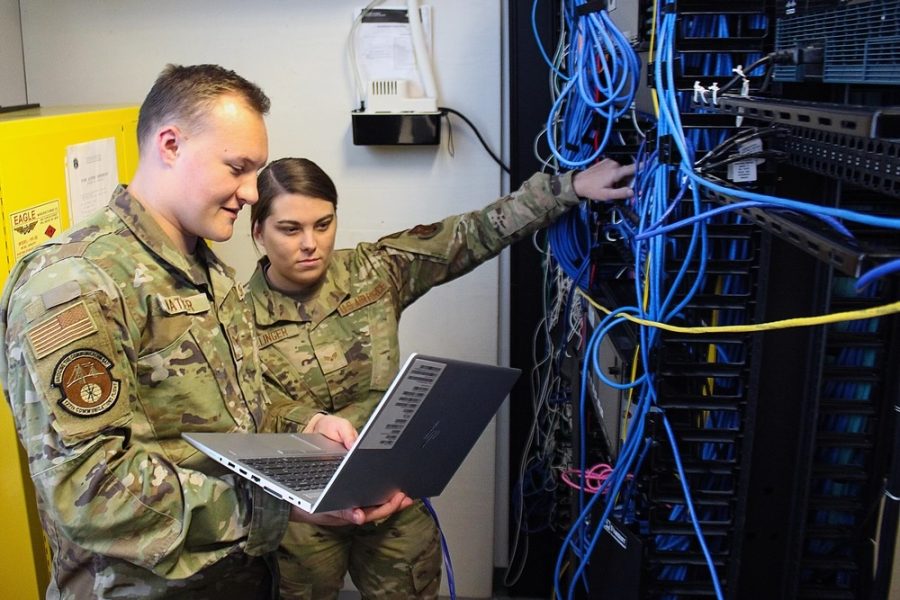AURORA, Colo.—The Air Force plan to bring back warrant officers will be limited to Airmen in the information technology and cyber career fields for the foreseeable future as the service evaluates the outcomes of the effort, Air Force Chief of Staff Gen. David Allvin said Feb. 12.
“We are going to be cautious before we broaden this beyond these particular career fields, because we want to make sure what we’re doing is fit for purpose, specific to the need that we have,” Allvin said in a keynote address at the AFA Warfare Symposium.
Allvin officially confirmed news first leaked last week on social media: the Air Force will try out bringing back warrant officers in a bid to retain highly-skilled technical specialists, 45 years after the last Air Force warrant officer retired in 1980. The Air Force and Space Force are the only military services not to include warrant officers, who fill technical rather than leadership functions in the other military branches.
“We are in a competition for talent, and we understand that technical talent is going to be so critical to our success as an Air Force in the future,” Allvin said. The warrant officer track could allow Airmen “to pursue the technical path without having to choose between that and the leadership path.”
Some people “just want to code for their country,” he added. “But everybody needs to see themselves in the future, beyond just this assignment or the next. So developing the warrant officer track for this narrow career field, we anticipate will help us drive that talent in and help us to keep that talent.”
Warrant officers could be important in cyber and software, where technology moves particularly fast, he explained.
A document posted anonymously on the unofficial Air Force amn/nco/snco Facebook page and the Air Force subreddit directs Air University to develop a concept of operations for establishing a training pipeline at Maxwell Air Force Base, Ala. The initial cohort, according to the document, would consist of 30 prior-service personnel, but a separate planning document obtained by Air & Space Forces Magazine says the pipeline could scale up to 200 junior warrant officers and 50 senior warrant officers a year.
Success may involve measuring how long warrant officers stay in the service, what level of talent they develop as warrant officers, and how much they increase productivity and effectiveness in the IT and cyber arenas. Those metrics may take years to collect, but Allvin cautioned against expanding the program too quickly.
“We’re still a force that develops leaders, so we’re not going to relegate the entire force to warrant officers,” he said. The same goes for the enlisted force, which he described as “the envy of the world and it scares the [bejesus] out of the adversary. We need to make sure we maintain that.”
The warrant officer program was one of several new personnel changes announced in the keynote panel, where Allvin, Air Force Secretary Frank Kendall, acting undersecretary Kristyn Jones, and Chief of Space Operations Gen. B. Chance Saltzman laid out 24 steps the service is taking to “reshape, refocus, and re-optimize” the Air Force and Space Force to prepare for possible conflict against a near-peer adversary such as China.
In that vein, the warrant officer program was just one of several “pathways” to sustaining technical expertise, according to an Air Force document that accompanied the announcements. Others include expanding technical tracks for officers, creating technical tracks for enlisted Airmen, and “tailored career categories” for “critical technical areas, notably cyber and IT.”
Other changes on the personnel side include:
- Expanding Air Education and Training Command and renaming it Airman Development Command. The move is meant to better align education and training efforts across the service to ensure “a more standardized Airman experience and development with a shared understanding of the threat environment,” and the “development of the right Airmen for the right place and time” according to the Air Force.
- Emphasize “Mission Ready Airmen,” by aligning Basic Military Training, tech school, doctorate and fellowship programs, and more with the current and future threats that the Air Force is preparing for, including how to work in small groups on difficult problems under contested conditions.
- “Mission Ready Airmen” would also apply to commissioning programs, where Allvin hopes to develop leaders who graduate those programs prepared to solve complex problems in small units cut off from higher levels of command.

